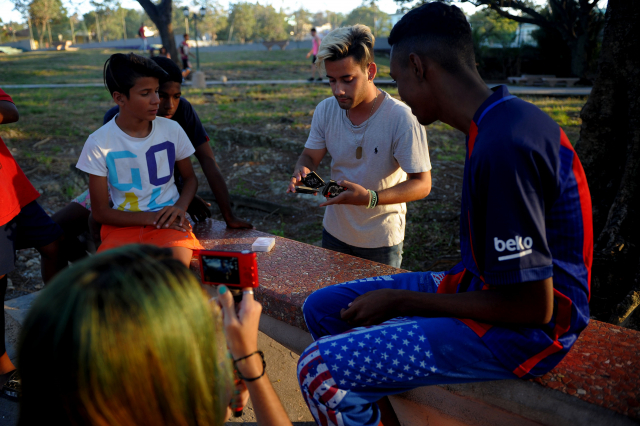
A Cuban youtuber records a magician’s performance for her youtube channel in Havana. Image: AFP/Yamil Lage
Frank Camallerys paces Havana’s Malecon esplanade with a telephone at the end of a pole, seducing thousands of internet users with images of Cuba despite the communist island’s limited web access.
Like other local stars of YouTube, and nearly the entire population of the island, the 19-year-old communications student has no internet at home.
So posting a video means a trek across Havana to a plaza where he can get access to wifi for a dollar an hour. It takes more than half an hour to upload his latest production to YouTube, which generally begins with his cheerful greeting: “Hello everyone, this is a new adventure in Cuba.”
Camallerys is among about 50 young Cubans who have become internet celebrities.
His “Camallerys Vlogs”, launched a year ago, now have more than 7,000 followers.
“Create a video, walk two or three kilometers (up to two miles) to put it online, then wait 40 minutes while it uploads: that shows very well how much I like this,” Camallerys says.
The public faces similar obstacles, unlike in much of the world where social media are easily accessed through mobile phones or home wifi.
In Cuba, internet content is disseminated through what’s known as “The Package”: a USB loaded with digital content which passes from hand to hand.
The distributors get the content from the regular internet and then offer it to homes for the equivalent of one dollar to people who can then download novels, the latest FC Barcelona soccer match, or American NBA basketball.
A dollar a day is roughly the average monthly wage for a government worker, but those in private enterprises can make far more.
“The Package” menu is updated weekly.
Emma Lopez, 18, knows well the benefits of the USB.
“The first time, my video was viewed by three people, until the Package began circulating and it helped me progress so that I eventually went countrywide,” she says.
Package and Backpack
Her channel, “Emma Style”, gives makeup tips to young Cubans, but adapted to a reality in which they might not have access to all the products.
Cuba’s economy remains under a United States trade embargo and state firms still account for 85 percent of the economy.
“If you don’t have a brush, use your fingers” to apply eyeshadow, Lopez advises in her show.
These mini-stars of the internet find audiences well beyond the Caribbean island.
“Normally when a YouTuber starts out, he hopes to have support of the population. But among my followers, a small percentage live in Cuba,” says Pedro Veitia, 24, of the Pedrito el Paketero channel.
“There are perhaps 50 of us in Havana,” he says of the small Cuban YouTuber community.
According to figures cited by the government of President Raul Castro, 4.5 million people on the island have internet access.
Unofficial estimates show the Package has nine million users in a Cuban population of 11 million residents, says Max Barbosa, a professor of communication at the University of Havana.
Officials have the right to control people’s access to content but they tolerate the Package and have even tried to compete with it by launching “The Backpack”, which is similar but with cultural content.
“Even if they don’t have internet to be connected all the time or to generate content, merely saying ‘I want to be a YouTuber,’ even by alternative means like the USB, is praiseworthy,” Barbosa says.
Their challenge now “is to start to create experiences more linked to the Cuban reality, to strike up a direct dialogue with the Cuban followers,” he adds.
That’s a goal Lopez aspires to.
“We don’t seek to be known as Cuban YouTubers just because it’s complicated for us or because we live in a communist island. We want to be recognized for our content,” she says. CC
RELATED STORY:
YouTuber accidentally kills boyfriend in failed gun stunt